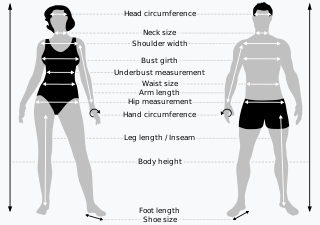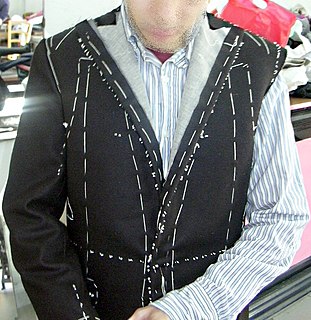 W
WClothing size refers to the label sizes used for garments sold off-the-shelf. There are a large number of standard sizing systems around the world for various garments, such as dresses, tops, skirts, and trousers. Made-to-order garments require measurements to be taken, but these do not need to be converted into national standard form.
 W
WBespoke tailoring is clothing made to an individual buyer's specifications by a tailor.
 W
WBra size indicates the size characteristics of a bra. While there are a number of bra sizing systems in use around the world, the bra sizes usually consist of a number, indicating the size of the band around the woman's torso, and one or more letters that indicate the breast cup size. Bra cup sizes were first invented in 1932 while band sizes became popular in the 1940s. For convenience, because of the impracticality of determining the size dimensions of each breast, the volume of the bra cup, or cup size, is based on the difference between band length and over-the-bust measurement.
 W
WA bustline is an arbitrary line encircling the fullest part of the bust or body circumference at the bust. It is a body measurement which measures the circumference of a woman's torso at the level of the breasts. It is measured by keeping a measuring tape horizontal and wrapping it around the body so that it goes over the nipples and under the arms.
 W
WThe joint European standard for size labelling of clothes, formally known as EN 13402 Size designation of clothes, is a European standard for labelling clothes sizes which has been partially adopted, and aims to make it easier to find and select fitting clothes. The standard is based on body dimensions measured in centimetres, and as such aims to allow for finding fitting clothing sizes by measuring the body with a tape measure or by comparing to already fitting clothing which conforms to the EN 13402 standard. The standard can therefore contribute to more environmentally friendly trade as it can lead to less return of clothes bought on the internet.
 W
WMaternity clothing is worn by women as an adaptation to changes in body size during pregnancy. The evolution of maternity clothing began during the Middle Ages, and became fashionable as women became more selective about style and comfort in the types of maternity clothing they wore. Fashions were constantly changing over time, such as the high-waisted Empire silhouette style maternity dress that was fashionable at the turn of the 19th century, and the "wrapper" style dress of the Victorian era that a woman could simply wrap around herself and button up.
 W
WIn sewing and fashion design, a pattern is the template from which the parts of a garment are traced onto fabric before being cut out and assembled. Patterns are usually made of paper, and are sometimes made of sturdier materials like paperboard or cardboard if they need to be more robust to withstand repeated use. The process of making or cutting patterns is sometimes compounded to the one-word Patternmaking, but it can also be written pattern(-)making or pattern cutting.
 W
WA shoe size is an indication of the fitting size of a shoe for a person.